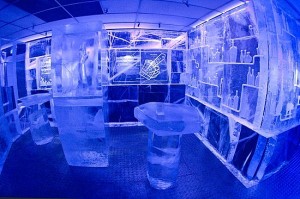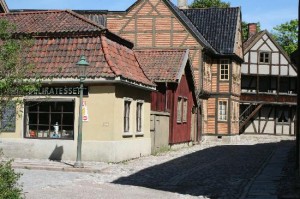This article is written by Parmanu, an Indian writer based in Germany
Since a week and a half I’ve been wrestling with the Oslo piece. The word processor tells me I have three thousand words; I think most of it is rubbish. An image from a nameless movie takes shape: a man is slumped over his desk, in front of a typewriter; crumpled pages are littered on the floor. That image carries a certain weight: physical traces of work done, of time spent. I do not have even that.
My first problem is with photographs of our trip. I cannot get them out of my head. The photographs bend the narrative around themselves, like gravity bends light, and soon they take over the narrative, making me write this or that episode about an image. I’ve had enough. I want to float free of gravity. Forget the photographs – there aren’t any in this piece. If you’re looking for an easy impression of Oslo, go elsewhere: Google some pictures, or visit Flickr.
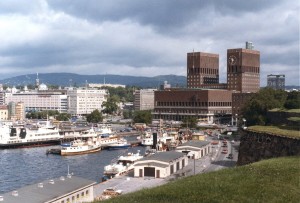 My second difficulty is with tone. I do not know who is telling the story. Is it a tourist? A wanderer? A traveler? A historian? An academic? An observer? An enquirer? A poet? An adventurer? The choice – or choices – here will determine the tone, and influence the voice. Don’t be dismissive, this isn’t a small matter: your impression of Oslo depends on this choice. The tourist, you see, is superficial. The wanderer digs deeper, but is selective. The traveller is more holistic, comprehensive. The historian delves into the past. The academic spells out theories. The observer gives you details without judgement. The enquirer probes, analyses, passes judgement. The poet, purely instinctive, relies on images. The adventurer does, then speaks.
My second difficulty is with tone. I do not know who is telling the story. Is it a tourist? A wanderer? A traveler? A historian? An academic? An observer? An enquirer? A poet? An adventurer? The choice – or choices – here will determine the tone, and influence the voice. Don’t be dismissive, this isn’t a small matter: your impression of Oslo depends on this choice. The tourist, you see, is superficial. The wanderer digs deeper, but is selective. The traveller is more holistic, comprehensive. The historian delves into the past. The academic spells out theories. The observer gives you details without judgement. The enquirer probes, analyses, passes judgement. The poet, purely instinctive, relies on images. The adventurer does, then speaks.
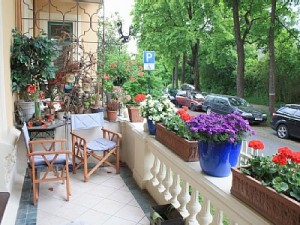 How do I get out of this mess? I could set aside these fancy tone-related notions and begin, for instance, with a simple description. I’m sitting in the balcony of our holiday-apartment in Oslo. The balcony faces south, and the morning sun on my cheeks makes the cold bearable. I can hear, over the rumble of some nearby motors, seagulls cawing. To my right is a small canal and a tree-lined path that runs along it. Occasionally a jogger passes by. Beyond our block are other plain-looking apartments and commercial buildings, about seven or eight storeys high. Two cranes, with long brick-red tentacles, signal ongoing development and re-development. In the distance, beyond the box-like structures with aluminium chimneys sticking out like cake-candles, a small hill rises gently from the east and tapers steeply to the west. I can see settlements – apartment blocks, clusters of single cottages – in the eastern side of the hill, and the west is covered with a dense foliage of pines.
How do I get out of this mess? I could set aside these fancy tone-related notions and begin, for instance, with a simple description. I’m sitting in the balcony of our holiday-apartment in Oslo. The balcony faces south, and the morning sun on my cheeks makes the cold bearable. I can hear, over the rumble of some nearby motors, seagulls cawing. To my right is a small canal and a tree-lined path that runs along it. Occasionally a jogger passes by. Beyond our block are other plain-looking apartments and commercial buildings, about seven or eight storeys high. Two cranes, with long brick-red tentacles, signal ongoing development and re-development. In the distance, beyond the box-like structures with aluminium chimneys sticking out like cake-candles, a small hill rises gently from the east and tapers steeply to the west. I can see settlements – apartment blocks, clusters of single cottages – in the eastern side of the hill, and the west is covered with a dense foliage of pines.
That perhaps is a start, but I cannot get far with armchair observation. You want to hear someone who has explored the place, seen things, met people. Like I did that first morning, a Saturday, when the city was asleep and the streets near our apartment were empty of traffic. My path crossed some unremarkable office blocks with dull exteriors, a poorly maintained metro entrance, and some old buildings almost in ruins. Filth had gathered in street corners. Homeless men slept next to a half-finished structure. Laid bare, stripped off its people, this was an underbelly of Oslo you wouldn’t find in guidebooks.
I hadn’t read any guidebooks, so I didn’t quite know what to expect. Wife and I had agreed not to learn anything in advance about Oslo – it remained a word in memory, a location on a map, nothing more. Arriving in the city on a Friday evening, I found that the street scenes near our holiday-apartment didn’t quite fit the image I had in mind:
Black men standing next to a tram stop, talking.
Round-faced black women in flowing robes and elegant headscarves, carrying grocery bags.
A brown-skinned bearded man in a shalwar-kameez, standing next to crates of vegetables and fruits.
A bunch of young men with North-African features, laughing at something.
Two blond teenagers, one with a guitar the other with a saxophone, both with tattoos on their arms.
“Did you know Oslo had such a mixed crowd?” I asked Wife.
“Oh yes!” she answered. “You suggested not to read about the place, but I did anyway.”
“Typical.” This was a woman who wouldn’t begin watching a movie until she’d read the synopsis and knew the ending by heart.
“They’re Somalis. The blacks, I mean. But the Pakis are the largest immigrant community in the city.”
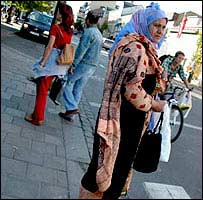 People of Pakistani origin in Little Karachi, Oslo
People of Pakistani origin in Little Karachi, Oslo
“Lonely Planet?”
“Wikipedia.”
We checked into our apartment. Sophie – plump and sweet, early twenties – showed us around and explained the systems: the key system, elevator system, garbage system, parking system. In the underground garage a rectangular key placed inside a square-shaped box moved a sliding grill, brought down a ramp and shifted another one aside to make way for our parking slot. It was the most complicated parking system I’d seen, and each time we parked in the next two days I’d be terrified of being locked inside by a system malfunction. Systems keep doing that to me all the time.
We weren’t far from the city-center, and a short walk led to a busy area full of immigrants. We passed an African restaurant, a Moroccan take-away, a Turkish kebab outlet. Coloured people – and that included us – outnumbered whites four to one; this could be a suburb of Paris. I withdrew cash at an ATM, reminding myself to divide by eight to convert Kroners to Euros. In a deli we bought bread, milk, juice, water. The amount on the bill was puzzling – had I got my math wrong?
“That’s another thing I read on Wikipedia, ” Wife said, as we exited the shop. “Oslo is the world’s most expensive city.”
I thought of what was coming tomorrow: a visit to the shopping district.
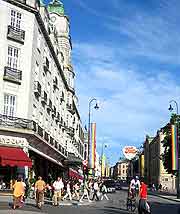 The Karl Johans Gate Shopping District in Oslo
The Karl Johans Gate Shopping District in Oslo
You’re beginning to settle into a rhythm. You’ve entered Oslo, gained an early impression of the city, and perhaps sensed the dynamics between the main characters, Wife and me. It should now be easy sailing for the author, you think.
But here we come upon the next challenge: out of the numerous images and encounters from the weekend, I have to pick a few to write about. But which ones? Do you wish to hear about the daughter of the Norwegian shipping magnate who went to the Olympics, or about the woman in the grocery store whose glance pierced through me? Are you the museum type person, interested in art and culture, or are you more keen on entertainment, the cool stuff? Does food interest you terribly, or is it technology that gets you excited?
Do I write what I know, giving you a well-rounded portrait of the city you’ll carry a long time, or do I write what I like, a skewed and quirky portrayal you will enjoy while reading but forget the next morning?
On Saturday evening we visited Icebar. Wife was keen to have a drink in this bar “made entirely of ice” and “kept at minus 5 degrees at all time.” Left with no option, I followed.
The place, brimming with tourists, resembled a museum entrance. Showcases lining the walls carried winter artifacts for sale. We were asked to wait for our turn (guests had 45 minute slots, and were sent inside in groups), and when it arrived a man in a suit threw over each of us an oversized blue-coloured costume with prickly fur lining the edges. (The website referred to it as “a designer thermal cape with a hood to keep you warm during your visit.”)
Inside, behind two thick doors, was a small room, dark and cold like a dungeon, with walls of ice and an aluminum floor. Ice barriers were stacked everywhere, creating a labyrinth to explore, until we reached a bar counter with a man in thick winter jacket and a silly aviator cap handing out drinks to others wearing costumes like ours. I tried not to think about how much I had paid to get in here.
It was the sort of place you would visit and later tell your friends on Facebook all about. Wife could not wait for later; she ‘checked-in’ using her iPhone, took pictures, uploaded them, and instantaneously, her six hundred friends knew we were dressed like witches, drinking a dark-coloured potion out of glasses made of ice, while all around us other Ku-Klux-Klan fellows stood taking pictures of each other in absurd poses. The only redeeming note was a Groucho Marx quote on a wall, chiseled in ice: “A black cat crossing your path signifies that the animal is going somewhere.”
That night, I dreamt of being stoned by witches while a black cat sat nearby, watching impassively. The stones, I realized at one point, were sharp and cold and smelled of liquor.
Earlier that day, we visited an Afro shop near our apartment to buy groceries. The place had the disorderly air of oriental retail shops in the West: irregularly stacked vegetable crates, packets strewn across shelves, grime on the floor and not enough space to move. A set of two or three steps led down from the main room to a larger hall with taller shelves set in long rows. There, at the end of a row stacked with cereals, two Somali women stood in headscarves and robes, talking in hushed tones. Both turned when I appeared around the corner, and then returned to their conversation. The shorter woman had a striking face: high cheekbones, sunken cheeks, sharp, curious eyes, eyes that seemed to glow against a dark complexion. I was distracted, and for a moment I forgot what I was looking for. Turning away, I walked to the end and came back in another row. When I saw them again, this time a few feet closer, the sequence was repeated, but now the shorter woman’s glance lingered a moment longer. I had seen those eyes before, but where? And why did I want to see them again?
“Did you find the salt?” Wife called, from the other end of the hall.
I picked the salt packet up and walked back.
On Sunday we took a tram and a bus to the only museum we visited, Folkemuseum.
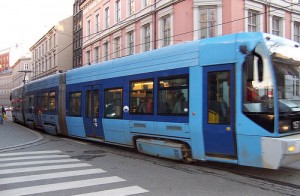 Public transport often provides clues to a city’s character. Oslo’s system was easy to figure out – buy tickets at Delis, punch them inside the tram or bus – and use. An electronic display at each stop displayed the expected arrival time for each line. The stop also had a chart explaining how the system worked. At the bottom, in not quite fine a print, was a guarantee: if your bus or tram was more than ten minutes late, the agency would reimburse the taxi fare to your intended destination.
Public transport often provides clues to a city’s character. Oslo’s system was easy to figure out – buy tickets at Delis, punch them inside the tram or bus – and use. An electronic display at each stop displayed the expected arrival time for each line. The stop also had a chart explaining how the system worked. At the bottom, in not quite fine a print, was a guarantee: if your bus or tram was more than ten minutes late, the agency would reimburse the taxi fare to your intended destination.
As we passed one stop after another, each with a large display bearing its name, I realized I was staring at the answer to a question that’s been puzzling me for a while: what is the real source of CAPTCHAs? You frequently encounter them as you wade through the Internet filling out forms or entering blog comments, those strange arrangement of letters you must type in to confirm you’re a human and not a robot trying to hack a top-secret database. I’ve wondered long about where the website authors get those creative names from. You’ll find many who say they are “generated” by a computer; the same people will swear that the Yeti exists and that crop circles are created by aliens practicing deviant-art. Truth is, CAPTCHAs are all sourced from Norway. Consider, for a moment, the list of names I spotted on our route:
Snarøya
Fornebu
Bygdøy
Kongskog
Vølund
Fjellro
Dælenenga
Bygdøynes
Do these ring a bell?
Folkemuseum, a museum of cultural history, was an open-air affair. It was a sunny day, and we strolled leisurely from one exhibit to next, each depicting a Norwegian dwelling – a barn, a house, a farm, a church – from the medieval ages until recent times. The girl at the information desk had pointed to a few spots on the map: “Do not miss the Stave church, ” she said, “and also this place where you can get traditional cakes!”
What I naively considered a personal recommendation from a chirpy young blonde turned out to be general spots-for-the-day guidance: all tourists had gathered around only these sites. The Stave church – a simple wooden structure with three or four successive sloping roof segments and a small tower on top – was a refreshing change after all the monumental stone edifices I’d seen elsewhere in Europe. The traditional cake, lefse, a flat and round bread made of flour, potato and milk, was served with a generous spread of butter. It tasted like aloo paratha with a tinge of sweetness, and melted instantly in my mouth. A pamphlet on the side outlined the ingredients, in Norwegian:
2 egg
250 gram sukker
125 gram smeltet smør/margarin
½ liter kulturmelk
1 teskje hjortetakksalt
ca. 1 kilo hvetemel
Later, near the end of our trip, we picked up a few packets from a store and smuggled them across the border.
The evening before we left Oslo, we met N. Daughter of a Norwegian shipping magnate, N was Wife’s B-School classmate. She had participated in the 1996 Olympic games in Atlanta, finishing seventh at the rowing double sculls event. A thirty-five year old mother of two children, she was on the board of her father’s shipping corporation, and also had a regular operations job in the firm. She continued to practice rowing at Olso’s top club, and competed in regional events. No one I knew – and no one on Wife’s Facebook friends list – measured up to her achievements. But achievements aren’t everything, I told Wife, as we waited for N in a Michelin-starred restaurant she’d reserved for the evening. And what could I possibly do if my father did not head a conglomerate? (And what, Wife added, could she possibly not do if her father headed a conglomerate.)
N arrived a few minutes late, dressed in a pink jacket over a light chiffon blouse and a cream-coloured pant. She kissed us both on the cheek, and said: “In Norway we only kiss once!” Members of their MBA class usually kissed thrice, a habit inherited from the Swiss during their year in Lausanne.
Conversation flowed easily. N spoke of her job at the corporation, where she scheduled ships from port A to port B to carry materials X, Y and Z. These variables were optimized to achieve maximum efficiency and profit, with minimum risk. Occasionally she travelled to these ports, to manage some transactions. They did not send ships across the Suez canal, so the Somali pirates were not a problem.
The Olympics experience was exceptional. Rowing did not usually attract a large audience, but a huge crowd had turned up in Atlanta. When the rowing team learned that they would be subjected to a gender test – a normal practice at the Olympics, apparently – everyone was curious about the method. In the end it was something prosaic: a swab of saliva was collected for a DNA test. Even then, N’s rowing partner was apprehensive about failing it; she did not kiss her boyfriend for a day or two, and gargled her mouth vigorously before the test.
Her children were still too young to row, but she’d agreed with her husband that her daughter will join her club while her son will join papa, who rowed in a rival club. She looked forward to the competitive days ahead.
After the main course – the best we’d had in Oslo – N ordered a glass of milk. Norwegians were fond of milk, she said. This explained the frequency of milk ads we’d seen on TV.
Despite her background, N retained the simplicity of a middle-class woman going through the normal course of life, full of everyday challenges at work and home, with the husband and children. She apologized for Olso’s expensive rates, and insisted on paying for dinner as she had chosen a high-end restaurant.
 It was past ten when we said goodbye to N at the Akersbrygge waterfront. A half-moon danced on water as we walked, hand in hand, towards the bus stop.
It was past ten when we said goodbye to N at the Akersbrygge waterfront. A half-moon danced on water as we walked, hand in hand, towards the bus stop.
I’ve exhausted my Oslo stories, and yet this piece feels incomplete. I’ve treated you, dear reader, with some slices that only hint at the whole. The reason became clear as I wrote this piece: the city had revealed only one of its faces, a temporal dimension that coincided with the timing of our visit.
Easter weekend in Oslo is a muted, damp affair. Many of the locals are away, travelling; cafes and restaurants are closed; a handful of tourists flock to popular spots, and the rest of the city wears a sparse, jaded look.
But this was no disappointment. Oslo was a base-camp on our road trip through Norway, a resting spot where we planned our next phase while gathering impressions of the city. It was now time to move on, towards the mountains and the fjords.
Parmanu
15 May 2011
If only I could write about Oslo
